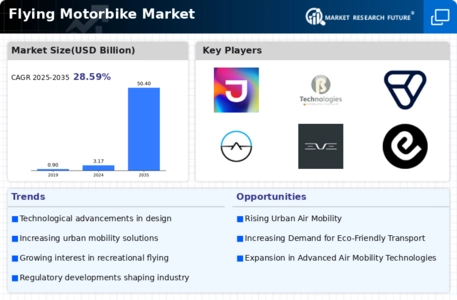The Flying Motorbike Market is currently characterized by a dynamic competitive landscape, driven by technological advancements and increasing consumer interest in personal aerial mobility solutions. Key players such as PAL-V (NL), AeroMobil (SK), and Jetpack Aviation (US) are at the forefront, each adopting distinct strategies to carve out their market positions. PAL-V (NL) focuses on regulatory compliance and safety certifications, which are critical for gaining consumer trust and market acceptance. In contrast, AeroMobil (SK) emphasizes innovation in design and functionality, aiming to integrate seamlessly into existing transportation infrastructures. Jetpack Aviation (US) is leveraging its expertise in jet propulsion technology to differentiate its offerings, suggesting a competitive environment that is increasingly reliant on technological prowess and regulatory navigation.
The business tactics employed by these companies reflect a concerted effort to optimize operations and enhance market presence. Localizing manufacturing has emerged as a key tactic, allowing companies to reduce costs and improve supply chain efficiency. The market structure appears moderately fragmented, with several players vying for dominance, yet the collective influence of major companies is shaping a more cohesive competitive environment. This fragmentation may lead to strategic partnerships and collaborations as companies seek to pool resources and expertise.
In August 2025, PAL-V (NL) announced a partnership with a leading aerospace firm to enhance its production capabilities. This collaboration is likely to streamline manufacturing processes and accelerate the development of its flying car model, positioning PAL-V to better meet the growing demand for personal aerial vehicles. Such strategic alliances may also facilitate knowledge transfer and innovation, further solidifying PAL-V's competitive edge.
In September 2025, AeroMobil (SK) unveiled its latest prototype, which incorporates advanced AI systems for navigation and safety. This development not only showcases AeroMobil's commitment to innovation but also highlights the increasing importance of technology in enhancing user experience and safety in the flying motorbike sector. The integration of AI could potentially set new industry standards, compelling competitors to follow suit.
Meanwhile, in October 2025, Jetpack Aviation (US) secured a significant investment to expand its research and development efforts. This funding is expected to accelerate the rollout of its next-generation flying jetpack, which promises enhanced performance and safety features. The influx of capital may enable Jetpack Aviation to maintain its technological lead and respond swiftly to emerging market demands.
As of October 2025, the competitive trends in the Flying Motorbike Market are increasingly defined by digitalization, sustainability, and the integration of advanced technologies. Strategic alliances are becoming more prevalent, as companies recognize the value of collaboration in navigating regulatory landscapes and enhancing product offerings. Looking ahead, the competitive differentiation is likely to evolve from traditional price-based competition to a focus on innovation, technological advancements, and supply chain reliability, suggesting a transformative shift in how companies position themselves in this burgeoning market.

















Leave a Comment